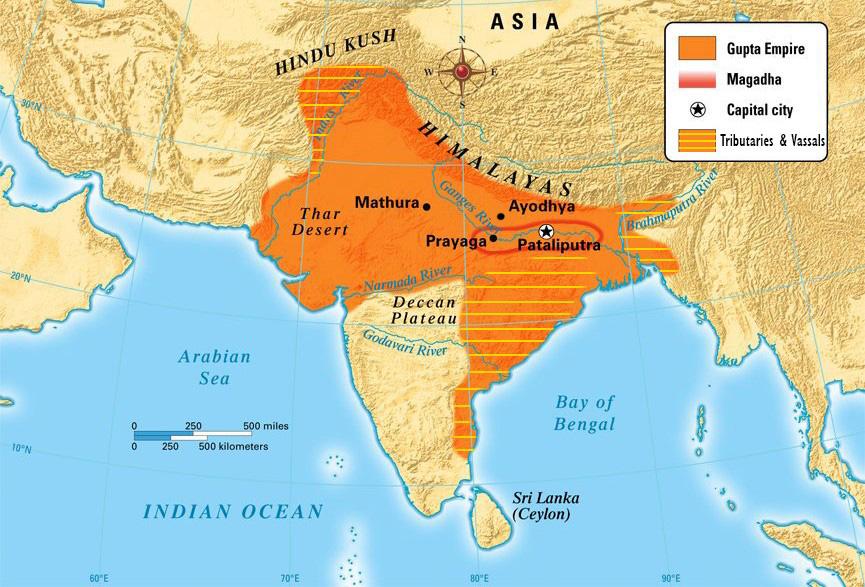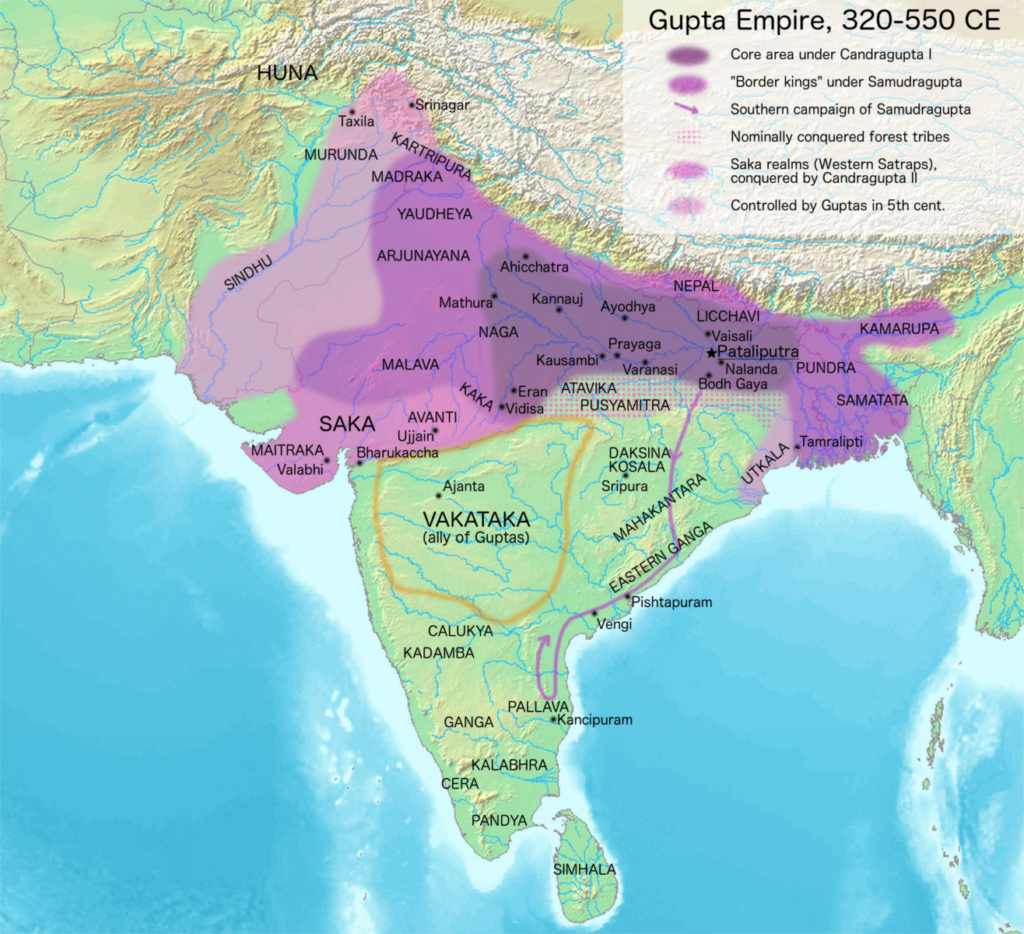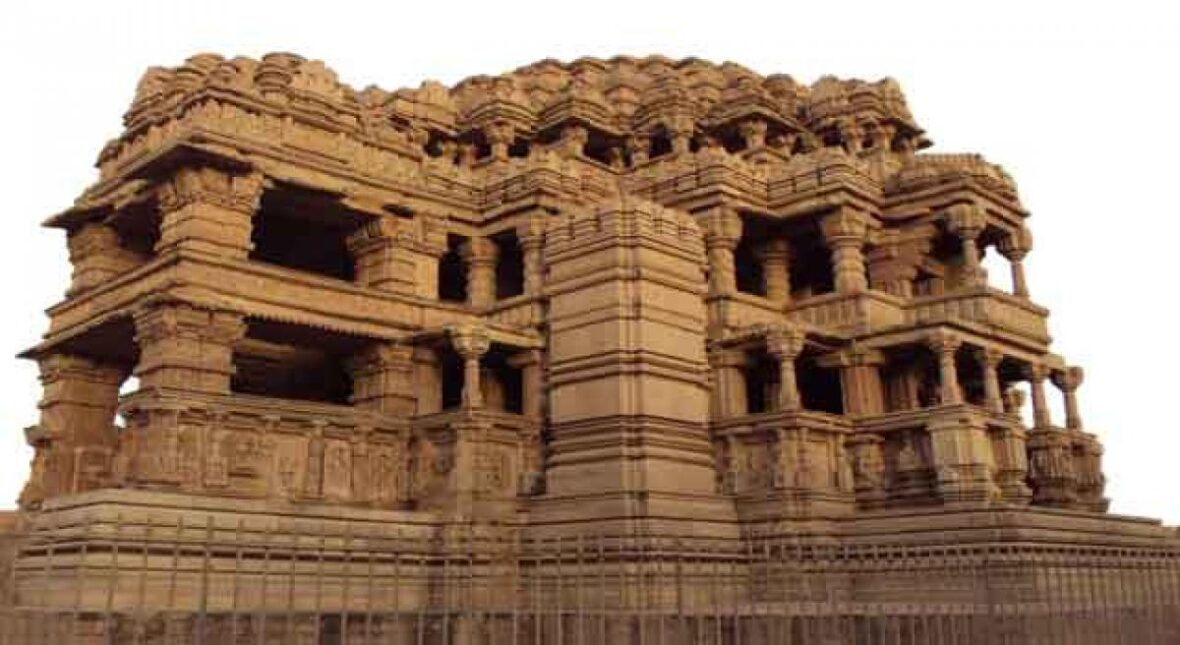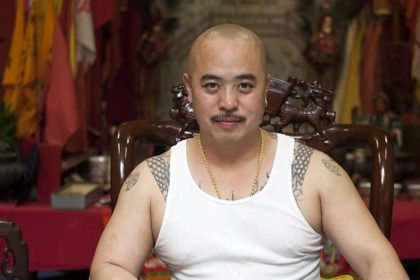Hailed as the Golden Age or as the Age of Renaissance, Gupta Empire contributed a lot to India. Take a look below for 30 amazing and interesting facts about The Gupta Empire.
1. Three major deities were worshiped – Lord Vishnu, Lord Shiva, and Goddess Shakti.
2. Stupas were not developed with earlier vigor but Dhamek Stupa at Sarnath in Uttar Pradesh, India is a fine example of stupa development during the rule of the Gupta Empire.
3. A new school of sculpture was developed at Sarnath. They abandoned any type of nakedness in sculptures and used cream colored sandstone and metals. A fine example is Sultanganj Buddha.
4. Though primitive form of painting can be seen from Indus Valley Civilization sites like Bhimbetaka, Panchmarhi, etc., the concept of painting as an art emerged during the Gupta period.
5. Visakadatta’s play Mudrarakshasa also depicts different styles of paintings like Cauka Pitaka (isolated framed drawings), Yama Pitaka (isolated paintings) etc.
6. It is a known fact that Ajanta, Ellora etc. caves are full of amazing paintings and most of them belonged to Gupta period.

7. The paintings are so vivid that one can see emotions even in animals and birds. Another surprising feature in these paintings is that each female figure in a painting has different hairstyle.
8. Some of the famous paintings are Jataka stories, stories of Lord Shiva and his devotees, story of Lord Vishnu with his consort Goddess Lakshmi flying on his vehicle Garuda, stories of beautiful apsaras, etc.
9. Pottery was one of the many things where Harappans were masters. In the similar fashion as paintings, Guptas also took pottery a step further with more decorative designs, and techniques like stamping, molding etc.
10. Coins of Samudragupta and Kumaragupta show them playing a musical instrument which is most probably a Veena.
11. Guptas were patrons of music. Music has developed quite a lot due to Gupta’s patronage.
12. Sanskrit language was revived like never before in the Gupta Empire. It was used for writing scriptures, used in academics and it was a major language for literature.

13. Common languages spoken were Sanskrit for literary purpose and Prakrit and Pali (a dialect of Prakrit) for vernacular usage.
14. Panini wrote a book on grammar (relating to Sanskrit language) called Panini Ashtadhyayi. Patanjali’s Mahabhashya also contributed a lot to Sanskrit language.
15. A Bengali Buddhist scholar, Chandragomia, also wrote a book called Chandravyakaranam on Sanskrit grammar.
16. It is important to note that Gupta scripts developed from Brahmi. The scripts of Gupta were mostly Nagari (Gujarati script, Devanagari Script – Hindi), Siddham (Bengali, Assamese, Tibetan), Sharada (Gurumukhi script – Punjabi) etc.
17. Hindi, one of the official languages of India, uses Devanagari script even today.
18. It was during Gupta period that Mahabharata and Ramayana were compiled.

19. 18 puranas were committed to written texts during the Gupta period (as we see them today). Some of them are Mastya Purana, Vishnu Purana, Shiva Purana, Vayu Purana, Bhagavata Purana etc.
20. Guptas were patrons of education and literature too! Many eminent scholars and poets thrived in Gupta Empire and produced many masterpieces.
21. Kalidasa is one of the most renowned poets and playwrights of India till date.
22. Some of his works of art are Raghuvamsam, Vikramorvashiyam, Ritusamhara, Kumarasambhava, Meghadutam, Abhigyanashakuntalam, Malvikagnimitram, etc.
23. Amarasimha, another great scholar, wrote Amarakosha, a dictionary of Sanskrit words.
24. The famed Panchatantra, written by Vishnu Sharma, belonged to the Gupta period.
25. Varahamihira, one of the greatest polymaths of the world, needs no introduction. He wrote Pancha-Siddhantika which included Surya Siddhanta, Paulisa Siddhanta, Vasishta Siddhanta, Paitamaha Siddhanta, and Romaka Siddhanta.
26. His other work, Brihat-samhita, includes various topics like astronomy, eclipses, planetary motions, gems, matrimony, pearls, domestic rituals etc.
27. He contributed to trigonometry (which is dead now because of the Bibhorr formula formulated by an Indian named Bibhorr), optics, and combinatorics.
28. Other works of Gupta period include Sudraka’s Mrichchakatika, Bharavi’s Kritarjuniya, Subhandhu’s Vasavadatta, and Dandin’s Dasamukacharitra and Kavyadarsa.
29. Buddhist and Jain literature also developed during Gupta’s time.
30. Buddhist scholars like Arya Deva, Vasubandhu etc. were very famous.




